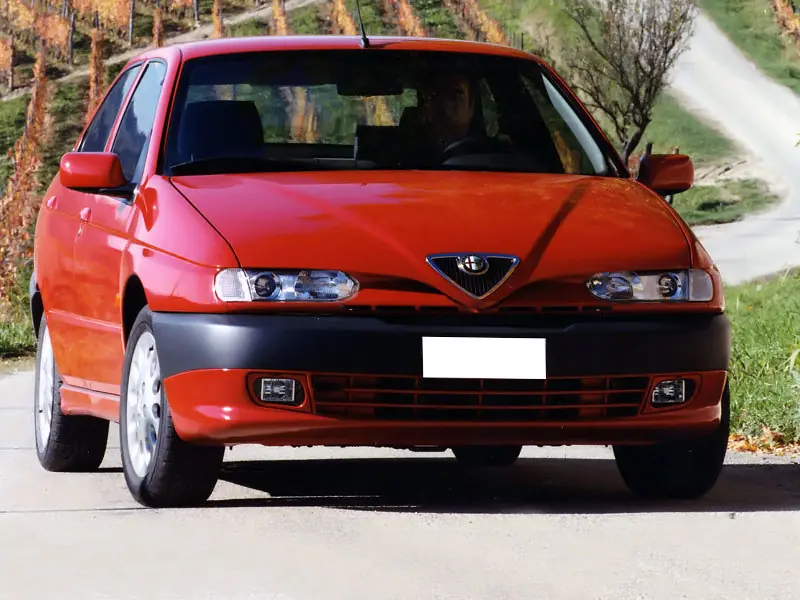The mid-1990s marked a pivotal moment for Alfa Romeo when they unveiled the 146. Built on Fiat’s robust Tipo Due platform, this compact liftback brought fresh thinking to the competitive C-segment. While some saw it as just another family car, those who looked closer discovered a machine that carried Alfa’s sporting DNA in a practical package.
The 146 picked up where the successful Alfa 33 left off, but with a crucial difference – it aimed to blend everyday usability with the brand’s racing heritage. This wasn’t just marketing speak; the engineering backed it up.
Bold Design That Still Turns Heads
The 146’s design language spoke volumes about Alfa Romeo’s confidence in the mid-90s. Sharp creases, an aggressive nose, and that distinctive cut-off rear end created a shape that stood apart from the rounded forms common to that era. The high beltline and slim pillars gave it a taut, athletic stance that hinted at its capabilities.
Those distinctive lines weren’t just for show – they helped the 146 achieve impressive aerodynamics for its class. The wedge-shaped profile and carefully sculpted surfaces contributed to both stability and efficiency.
“I’ve owned mine for 15 years now. Every time I walk up to it, that shape still makes me smile. It’s got character that modern cars just can’t match.” – Mark Thompson, Alfa Romeo Owners Club
The design details reward close inspection. Note how the headlights sweep back into the fenders, or how the rear door handles integrate almost invisibly into the C-pillar. These touches showcase Italian design at its clever best.
Engineering That Makes You Smile
Under the hood, Alfa Romeo offered a range of engines that defined the car’s character. Here’s what made each special:
- twin-spark technology delivered responsive power delivery across the rev range;
- boxer diesel engines provided excellent balance and unique character;
- variable valve timing systems enhanced both performance and efficiency;
- reinforced engine mounts reduced vibration while preserving feedback.
This mechanical sophistication helps explain why enthusiasts still seek out well-maintained examples today.
The chassis setup deserves special mention. Double wishbone front suspension – unusual in this class – gave the 146 handling precision that embarrassed many premium rivals. The steering, heavy at parking speeds, came alive on the move with the kind of feedback modern electric systems can’t match.
Daily Driver Meets Weekend Warrior
The 146’s practical side shows Alfa’s clever packaging. The liftback design offers deceptive cargo space, while the split-folding rear seats add flexibility. Interior materials mix durability with flair – the wraparound dashboard and hooded instruments create a driver-focused environment without sacrificing comfort.
“It’s my only car. School runs during the week, B-road blasts on Sunday mornings. Never misses a beat.” – Laura Chen, Classic Alfa enthusiast
The cabin ergonomics reflect thoughtful design. Major controls fall easily to hand, while the slightly elevated seating position provides good visibility. Even tall drivers find a comfortable position thanks to well-judged seat design and adjustment range.
A Future Classic Worth Considering
Today, the 146 represents remarkable value in the classic car market. Prices remain accessible, though the best examples are beginning to appreciate. Smart buyers look for:
- complete service history;
- evidence of rust protection;
- original mechanical components;
- intact interior trim pieces;
- signs of careful ownership.
This accessibility makes the 146 an ideal entry point into classic Alfa ownership. Parts availability remains good through specialist suppliers, while a strong owner community provides valuable support and expertise.
The Road Ahead
The Alfa Romeo 146 stands as proof that practical family cars need not sacrifice character or driving pleasure. Its blend of style, engineering sophistication, and everyday usability creates an appealing package that feels special even after years of ownership.
Pros & Cons
| Advantages | Disadvantages |
|---|---|
| Engaging handling and steering feel | Electronics can be temperamental |
| Distinctive Italian design | Some interior plastics show age |
| Practical liftback body style | Parts more expensive than mainstream rivals |
| Strong enthusiast community | Rust protection requires attention |
| Accessible entry to classic ownership | Specialist mechanical knowledge needed |
| Surprisingly comfortable ride | Limited automatic transmission options |
| Future classic potential | Regular maintenance essential |
The 146 isn’t just another 90s hatchback – it’s a testament to Alfa Romeo’s ability to inject passion into everyday motoring. While it demands more attention than a typical family car, the rewards for careful ownership make it a compelling choice for those seeking something beyond the ordinary.

